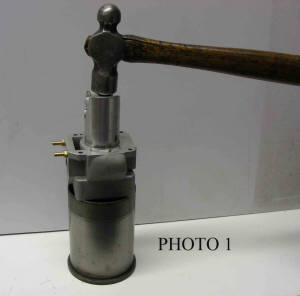
REPLACEMENT SLIP IN SLEEVE INSTRUCTIONS, scroll down, see Photos below.
If you have a shrink in sleeve to start with you need to heat your cylinder casting up to 350 degrees F (177 degrees Celsius). Do NOT heat it any hotter than this or you will take the heat treat out of the casting. Also do not heat it up any longer than necessary for the same reasons. You can do this a propane torch if you are careful and you don’t overdo it but a preheated oven with a reliable temperature control is probably safer. See warning below:
WARNING: Your cylinder casting and sleeve are going to be hot and it will burn you if you touch it, so make sure you use good gloves made for these high temperatures! Be sure to remove the Iso block and carburetor before you do this.
Set your casting upside down over something round and find something that just fits the sleeve and lightly tap on it to knock the old sleeve out. See photo #1. With one or two light taps it should just fall out. DO NOT hammer on the sleeve hard, if it does not come out easy then something is wrong. (If you have a lot of damage in your old sleeve from something like sucking a carburetor screw in the engine or a wrist pin cir-clip coming out, you may have to cut the old sleeve out. This is a little tricky, you have to cut up the cylinder wall with a Dremel tool and just barely cut to the edge of the diameter of the sleeve without gouging the aluminum casting. You can do this from port to port so there is less grinding to do. This will relieve the tension on the sleeve if it is bent from damage. It should then slip out without too much effort.)
The New Slip in Sleeve slips in the casting when the casting is at room temperature, it is not a shrink fit sleeve as the originals are.
Once the old sleeve is out, let the casting cool down to room temperature, clean it up and make sure there are no burrs or dings in the aluminum bore of the casting, if there are then use some fine sandpaper to knock the high spots off, but DO NOT create low spots by overdoing it. Once the casting is clean put a very light coat of 2 stroke oil on the inside the casting wherever the sleeve touches. DO NOT get oil on the top flange of the casting. On this top flange put a very thin coat of silicone to seal the sleeve flange to the casting so no water will leak between the sleeve and casting, see photo #2. DO NOT get any silicone sealer in the bore of the aluminum casting, this will cause bad heat transfer wherever the silicone is and can cause hot spots and piston seizures.
Now slide the NEW sleeve in a rotating motion until it seats against the flange. The ports to line up are the small dividers between the two transfer ports on each side. These very small dividers between the 2 ports is what you want to line up the best with the casting. Don’t worry about the rest of the ports, these dividers are the most critical spots. See photo #3 & #4.
You will have to check and possibly adjust your deck height, see FAQ #29 on how to do this. Standard stroke Pioneer engines deck height is .010" to .012". Stroker 29.5 Pioneers deck height is .011" to .012".
Stroker 27 Pioneers deck height is .018" to .020" inches.
When you reinstall the head button, torque it to 15 inch pounds. NOTE: this is Inch pounds, not Foot pounds.



